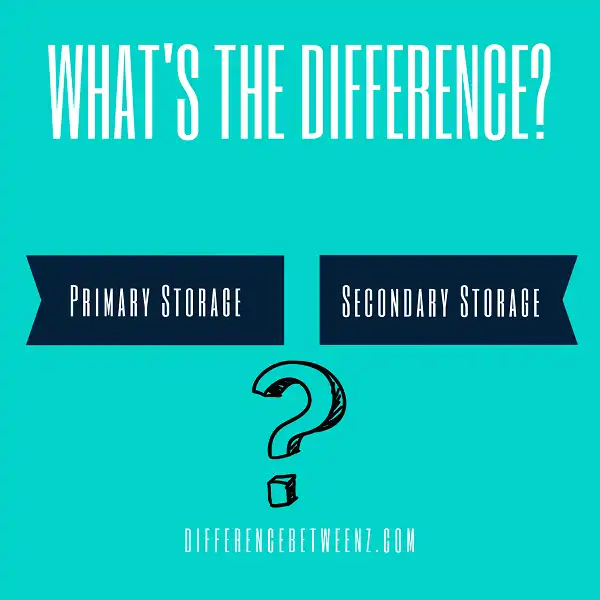What is the difference between primary storage and secondary storage? Primary storage is where your computer’s operating system and software are kept, while secondary storage is used for data that you don’t need to access as often. For example, if you store photos on your computer, you would want to keep those on the primary storage drive, because they’re accessed frequently. If you have a lot of music files, however, you might want to move them to the secondary storage drive, because you don’t need to access them as often. This way, your computer can run faster because it doesn’t have to load all of the photos every time it starts up.
What is Primary Storage?
Primary storage, also called memory or internal storage, refers to the hardware within a computer where data is stored for quick access by the computer’s processor. RAM (random access memory) and cache are both examples of primary storage.
- Primary storage is volatile, meaning it only stores data temporarily and erases it when the power is turned off. In contrast, secondary storage contains data that is stored permanently, even after the power is turned off.
- It acts as an archive for files and documents that are not in active use. Hard drives, optical drives, and flash drives are all examples of secondary storage. Unlike primary storage, secondary storage is non-volatile, meaning it retains data even when the power is off.
- Primary storage is much faster than secondary storage because it doesn’t have to retrieve data from a physical location like a hard drive. However, it is also much more expensive and has limited capacity compared to secondary storage. When deciding what type of storage to use, it’s important to consider both cost and speed.
What is Secondary Storage?
- Secondary storage is a type of computer storage that is not directly accessible by the CPU. It is usually slower than primary storage, but it can store more data and retain it for a longer period of time.
- Secondary storage can be either internal or external to a computer. Internal secondary storage devices include hard drives and solid-state drives. External secondary storage devices include USB flash drives, external hard drives, and optical discs such as CDs and DVDs.
- Secondary storage is often used for long-term data retention, such as for backups or archival purposes. In some cases, data stored in secondary storage may be transferred to tertiary storage, which is even slower and can store even more data for an even longer period of time.
Difference between Primary Storage and Secondary Storage
Primary storage also called main memory or internal memory is the computer’s principal storage location. Everything that the CPU can access has to be stored in primary storage, which is usually a form of fast, random-access memory (RAM).
- Secondary storage, on the other hand, is not directly accessible by the CPU. It is used for the long-term storage of data and programs. Examples of secondary storage devices include hard disks, solid-state drives (SSDs), and Optical discs. When data needs to be accessed from secondary storage, it is first copied into primary storage, which operates at much higher speeds.
- One key difference between primary and secondary storage is that while primary storage is volatile (meaning it stores data only temporarily), secondary storage is non-volatile (meaning it stores data permanently). This means that when power is turned off, all data stored in primary storage is lost, while data stored in secondary storage remains intact.
- Another key difference is that primary storage is much faster than secondary storage. This is because primary storage uses dynamic RAM (DRAM), while most secondary storage devices use slower static RAM (SRAM) or rotating magnetic media such as hard disk drives.
Finally, primary storage typically has much less capacity than secondary storage. This is because DRAM chips are currently more expensive per byte than SRAM or rotating media. As a result, computers usually have only a few gigabytes of DRAM, while they may have hundreds of gigabytes or even terabytes of secondary storage.
Conclusion
In conclusion, primary storage is the first place that data goes when it is stored on a computer. Secondary storage is used for long-term storage and retrieval of files. The two types of storage have different purposes, and understanding the difference between them can help you better manage your data.


